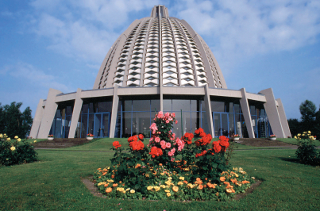Land of Mím
See Mázindarán
Land of Mystery
See Adrianople
Land of Ṣád
See Iṣfahán
Land of Ṭá
See Ṭihrán
The plain of Karbilá in which vicinity Imám-Ḥusayn was martyred.
A-Z : Ṭaff ~ land of
Mother Temple of Europe

Image copyright ©
Bahá’í International
Community
Architect: Teuto Rocholl
The corner-stone for the House of Worship was laid by Hand of the Cause of God Amelia Collins on the 20th November 1960. The dedication was held on the 4 July 1964, attended by Amatu’l-Bahá Rúḥíyyih Khánum, who represented the Universal House of Justice
See also : Mashriqu’l-Adhkár.
Language of Ḥijáz
See Ḥijáz
A quirk of Greek grammar that lists results before causes, reversing the usual chronological sequence of English.
A rural district lying to the east of Ṭihrán
Lawḥ-i-Fu’ád
See Fu’ád Páshá
Text : Lawḥ-i-Ra’ís
“Leprosy may be interpreted as any veil that interveneth between man and the recognition of the Lord, his God.” (Gleanings from the Writings of Bahá’u’lláh, XXXVI, p. 86)
A-Z : Leprosy
Lesch, Mary
See Mary Lesch
Lesser Covenant
See Covenant
The first of two major stages in which Bahá’ís believe peace will be established.
The Lesser Peace will come about through a binding treaty among the nations for the political unification of the world. It will involve fixing every nation’s boundaries, strictly limiting the size of armaments, laying down the principles underlying the relations among governments, and ascertaining all international agreements and obligations.
Its inception will synchronize with two processes operating within the Bahá’í Faith – the maturation of local and national Bahá’í institutions and the completion of specified buildings around the Arc on Mount Carmel and will portend the coming of the Most Great Peace.
A-Z : Peace ~ Lesser
A translation of Ḥurúf-i-Ḥayy.
The first eighteen people who independently recognized and believed in the Báb. Together with Him, they form the first Vaḥíd (“Unit”) of the Bábí Dispensation.
The word Ḥayy, which is the Name of God “The Living”, has the numerical value of eighteen in the abjad system of notation in which each letter of the Arabic alphabet is assigned a specific numerical value.
A-Z : Letter(s) ~ of the Living
Apostles of the Prophet Muḥammad.
A-Z : Letter(s) ~ of Unity
An unidentified aquatic monster; whale or serpent.
A-Z : Leviathan
1904 — 1944

A Bahá’í from Warsaw who learned of the Faith from Martha Root.
The daughter of Dr. Ludwig Zamenhof, creator of the international language Esperanto, she translated numerous works of Bahá’í literature into Esperanto and traveled widely to spread the message of Bahá’u’lláh and teach Esperanto.
In 1942 she and her family, who were Jews, were taken to a concentration camp. Two years later she died in the gas chamber at Treblinka. Commemorative observances were held for her throughout Canada and the United States in October of 1946.
For a brief account of her life and service to the Faith, see The Bahá’í World 10: 533-38.
The Bahá’í Fund.
Local Spiritual Assembly
A title of Bahá’u’lláh. ‘Abdu’l-Bahá explains that “what is meant in the prophecies by the ‘Lord of Hosts’ and the ‘Promised Christ’ is the Blessed Perfection [Bahá’u’lláh] and His holiness the Exalted One [the Báb].”
See also : Hosts.
Ṣáḥibu’z-Zamán
A designation of the Manifestation of God in each Dispensation.
In Islám it was a title given to the promised Qá’im and, therefore, is applied in Bahá’í terminology particularly to the Báb.
Lote-Tree, Divine
See Divine Lote-Tree
Lotus Temple
Louisa A. Moore
See Lua Getsinger
1871 — 1916

National Bahá’í Archives
United States
Nee Louisa A. Moore; an outstanding early American Bahá’í who traveled widely in the United States, Europe, and India to teach the Faith.
Named by ‘Abdu’l-Bahá “Livá”, meaning “Banner of the Cause,” and designated by Shoghi Effendi as “the mother teacher of the West,” she was among the first Western pilgrims to visit ‘Abdu’l-Bahá in ‘Akká in 1898.
For an account of her life and service to the Faith, see Velda Piff Metelmann, Lua Getsinger: Herald of the Covenant (Oxford: George Ronald, 1997).
Lunt, Alfred E.
See Alfred E. Lunt